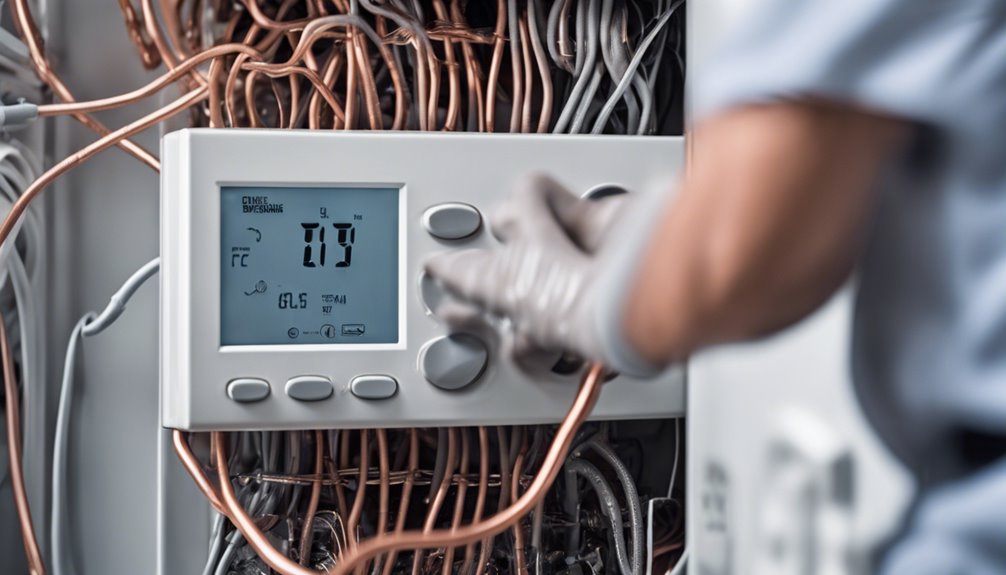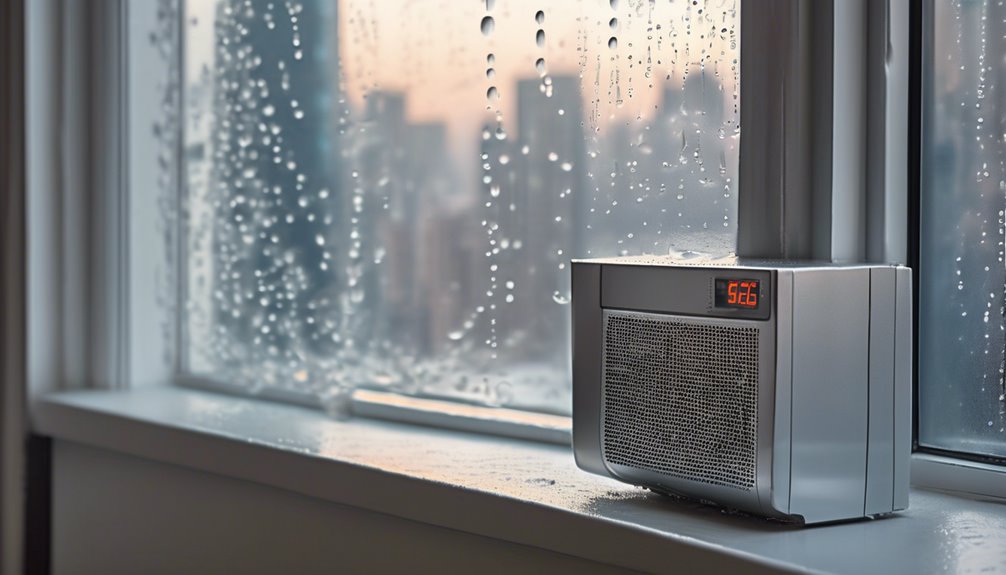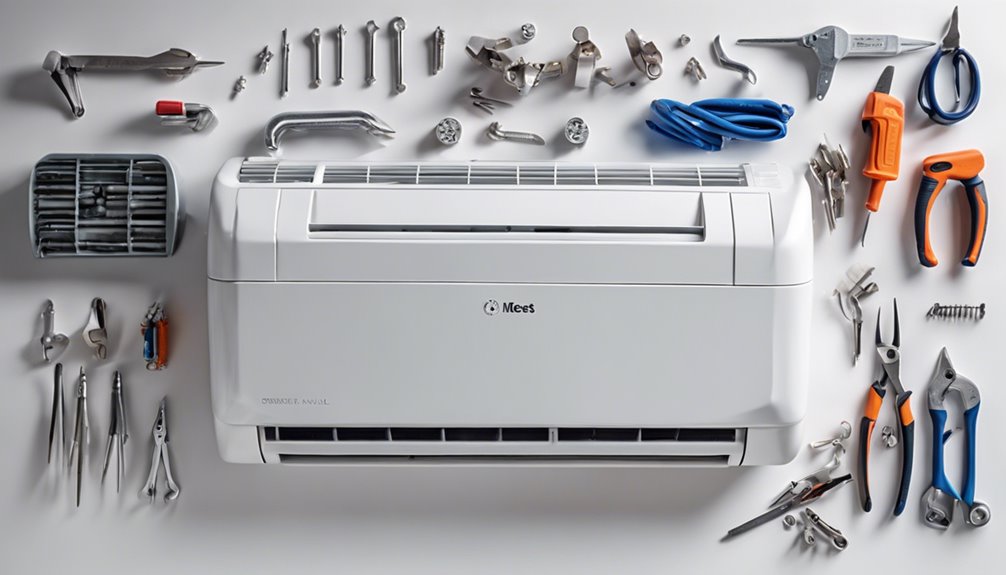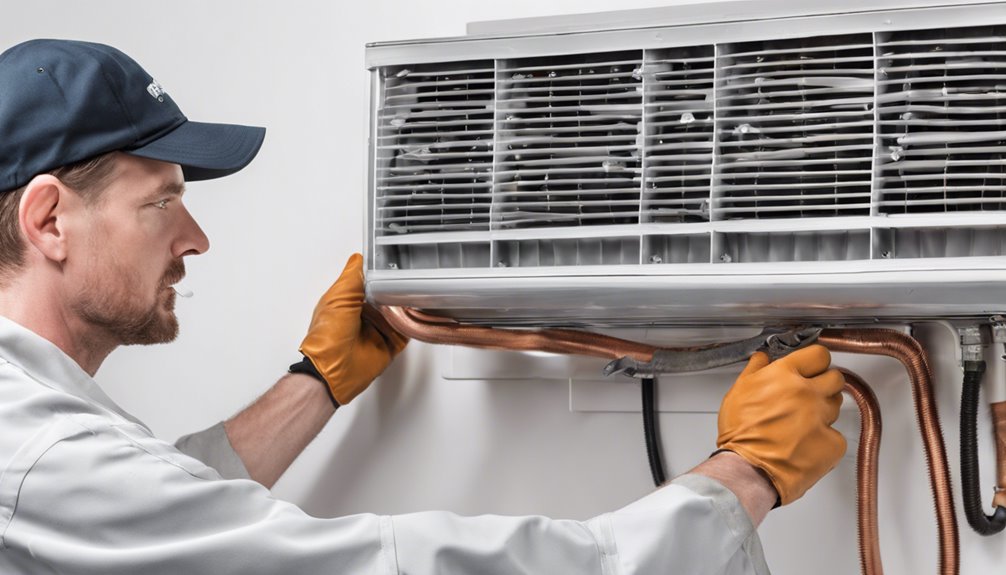To get an accurate AC installation cost estimate, you'll need to follow a series of crucial steps. Start by determining your cooling needs, considering factors like home size and local climate. Next, choose the right AC type for your space, weighing options like window units and central AC systems. Research local installation companies, getting multiple quotes and verifying contractor credentials. Consider the SEER rating and energy efficiency, as well as ductwork and installation costs. Factor in additional features and upgrades, and review warranties and maintenance requirements. By following these steps, you'll be well on your way to getting a reliable estimate – and if you want to ensure you're covering all your bases, keep exploring to get the best results.
Key Takeaways
- Determine cooling needs by assessing home size, windows, insulation, and local climate to calculate the necessary cooling capacity in BTUs.
- Research and select a reputable contractor by comparing prices, services, and warranties, and verifying credentials and reputation through online reviews.
- Consider energy efficiency by choosing an AC with a high SEER rating, and factor in additional costs like maintenance and repair services.
- Ensure proper ductwork installation by checking permits, material costs, and labor costs, and designing a well-sized duct system for optimal performance.
- Consider upgrading to features like smart thermostats, advanced filtration, and zone control to optimize energy efficiency and comfort.
Determine Your Cooling Needs
How much cooling power do you really need?
Determining your cooling needs is the first step in getting an accurate AC installation cost estimate.
A home assessment will help you figure out the right cooling capacity for your space.
Consider factors like the size of your home, number of windows, insulation, and local climate.
A professional can assess your home's unique requirements and calculate the necessary cooling capacity in British Thermal Units (BTUs).
Don't overspend on an AC that's too powerful or underspend on one that's too weak.
Get it just right with a thorough home assessment.
This will ensure you get the perfect AC for your needs and a cost estimate that's spot on.
Choose the Right AC Type
You'll need to decide between a window unit and a central AC system, each with its own set of benefits and drawbacks.
Window units are a cost-effective option for cooling a single room, while central AC systems can cool your entire home.
You should consider factors like your budget, the size of your space, and your desired level of energy efficiency when making your decision.
Window Unit Options
Choosing the right air conditioning type can make all the difference in effectively cooling your space while staying within your budget.
When considering window unit options, you'll want to think about your window styles and room layouts. For instance, if you have smaller windows, a compact window unit might be the way to go.
On the other hand, larger rooms or those with multiple windows may require a more powerful unit. Measure your windows and assess your room's cooling needs to determine the best window unit for you.
This will ensure you get the right fit and avoid wasting energy or money on an inefficient system.
Central AC Systems
Central air conditioning systems are a popular choice for many homeowners due to their ability to cool entire houses efficiently.
They're ideal for larger homes or those with complex layouts. When choosing a central AC system, consider factors like air quality and system design.
Look for systems with built-in air purification features to improve indoor air quality. A well-designed system will distribute cooled air evenly throughout your home, ensuring consistent temperatures in every room.
Consider consulting with a professional to determine the best system design for your home's unique needs. They'll help you select the right system size, ductwork, and vent placement to maximize efficiency and comfort.
Research Local Installation Companies
Researching local installation companies is a crucial step in finding the best fit for your AC installation needs.
You'll want to create a list of potential companies to compare their services, prices, and reputations.
Check online directories like Yelp or Google Reviews to see what past customers have to say about their experiences.
Look for companies with high ratings and pay attention to the comments – do they respond to customer complaints?
Do they've any certifications or awards?
Make a side-by-side comparison of each company's services, warranties, and pricing.
This will help you narrow down your options and ensure you're getting the best deal for your money.
Get Multiple Quotes From Contractors
Once you've narrowed down your list of potential installation companies, it's time to get multiple quotes from contractors.
This step is crucial in ensuring you get the best deal for your AC installation. Reach out to at least three contractors and ask for a detailed quote that includes the type of AC unit, installation cost, and any additional features or services.
Be sure to ask about any warranties, maintenance, and repair services they offer. Compare the quotes carefully, paying attention to the prices, services, and warranties.
This will help you make an informed decision and avoid hidden costs. Through quote comparisons and contractor research, you'll be able to identify the most reliable and cost-effective option for your AC installation needs.
Consider the SEER Rating and Energy Efficiency
When choosing an AC unit, you'll want to consider the SEER rating, which measures its energy efficiency.
A higher SEER rating means lower energy bills and a reduced environmental impact. By selecting a unit with a high SEER rating, you'll reap the benefits of energy efficiency, which can lead to significant cost savings over time.
SEER Rating Explained
You've likely come across SEER ratings while shopping for a new air conditioner, but what do they really mean?
SEER stands for Seasonal Energy Efficiency Ratio, which measures an AC's cooling performance. It's calculated by dividing the total cooling capacity by the total electrical energy input during a typical cooling season.
In the US, the Department of Energy sets energy standards, and SEER ratings range from 13 to 25. A higher SEER rating indicates higher energy efficiency, which translates to lower energy bills and a reduced carbon footprint.
When choosing an AC, look for a SEER rating that meets your needs and budget. A higher rating may cost more upfront, but it'll pay off in the long run.
Energy Efficiency Benefits
Efficiency is key to unlocking long-term savings and a clearer conscience.
When you invest in a high-SEER AC unit, you'll reap the benefits of reduced energy consumption. Conducting energy audits helps identify areas of improvement, ensuring your new AC system operates at peak efficiency.
You might even be eligible for cooling incentives, such as rebates or tax credits, which can offset the initial installation cost. By choosing an energy-efficient AC, you'll not only lower your utility bills but also minimize your environmental footprint.
Plus, many energy-efficient models qualify for special financing options or government incentives, making them more accessible than you think.
Check for Any Necessary Permits and Licenses
Your new air conditioning installation requires more than just technical expertise – it also needs the green light from local authorities.
Before the installation begins, you'll need to check if any permits or licenses are required. This varies depending on your location, so it's essential to research local regulations and municipal requirements.
Failing to obtain the necessary permits can result in fines, penalties, or even having the installation shut down. Make sure you understand what's required and factor in the time and cost of obtaining these permits into your overall installation cost estimate.
This will ensure a smooth and hassle-free installation process.
Factor in Ductwork and Installation Costs
When you're calculating the total cost of your AC installation, you'll need to consider the ductwork material costs, which can vary depending on the type and quality of materials used.
Additionally, you'll need to factor in duct installation labor costs, which can add up quickly depending on the complexity of the job.
Finally, you'll need to think about duct sizing and design, which can impact both the performance and efficiency of your new AC system.
Ductwork Material Costs
Ductwork material costs make up a significant portion of your total AC installation cost.
When it comes to ductwork, you'll need to consider the material options and insulation types that best fit your needs.
- Galvanized steel: A popular choice due to its durability and resistance to corrosion.
- Fiberglass duct board: A cost-effective option that provides decent insulation and is easy to install.
- Flexible ducting: Ideal for tight spaces and can be bent to fit around corners and obstacles.
Keep in mind that each material has its pros and cons, and your choice will impact your overall AC installation cost.
Be sure to research and compare prices to find the best fit for your budget.
Duct Installation Labor
Labor costs for duct installation play a significant role in your overall AC installation expense.
When you're calculating the total cost, you'll need to factor in the labor costs associated with duct installation. These costs can vary depending on the complexity of the installation, the location, and the contractor's rates.
On average, you can expect to pay between $35 and $55 per hour for a licensed HVAC technician. For a standard duct installation, the total labor cost can range from $500 to $2,000 or more, depending on the size of your home and the number of vents.
Be sure to get quotes from multiple contractors to find the best deal for your duct installation labor costs.
Duct Sizing and Design
You've got your labor costs factored in, but now it's time to think about the ductwork itself.
Proper duct sizing and design are crucial for efficient airflow and optimal system performance.
A well-designed duct system ensures that your AC unit operates at its best, while a poorly designed one can lead to energy losses and increased energy bills.
To ensure your ductwork is up to par, consider the following key factors:
- Duct layout: A well-planned duct layout ensures that airflow is distributed evenly throughout your home, with minimal restrictions or leaks.
- Airflow optimization: Proper sizing of ducts and vents ensures that airflow is optimized, reducing energy losses and improving overall system efficiency.
- Material quality: Choose high-quality duct materials that can withstand the elements and minimize air leaks, ensuring your system operates at its best.
Evaluate Additional Features and Upgrades
Your air conditioning installation is more than just a basic unit – it's a comprehensive system that can be tailored to meet your specific needs and preferences.
You can upgrade to a smart thermostat, which learns your schedule and preferences to optimize energy efficiency and comfort.
Advanced filtration systems can also be integrated, providing cleaner air and improved indoor air quality.
Consider adding features like zone control, which allows you to cool specific areas of your home, or a whole-house dehumidifier to reduce humidity levels.
These upgrades may increase the overall cost, but they can provide long-term benefits and improve your overall comfort and well-being.
Review Warranties and Maintenance Requirements
As you finalize your AC installation plans, it's essential to review the warranties and maintenance requirements that come with your new system.
This ensures you understand the manufacturer terms and what's covered in case of defects or malfunctions.
- Standard warranty: Review the length and coverage of the standard warranty, including what's included and what's excluded.
- Extended coverage: Check if you can purchase extended coverage for additional protection and peace of mind.
- Maintenance requirements: Understand the recommended maintenance schedule to keep your warranty valid and your system running efficiently.
Verify Contractor Credentials and Reputation
Before hiring a contractor to install your new AC system, take the time to verify their credentials and reputation.
You want to ensure you're hiring a qualified professional who can get the job done efficiently and effectively. Check online contractor reviews on sites like Yelp, Angie's List, or Google Reviews to see what past customers have to say about their experience.
Look for business ratings from organizations like the Better Business Bureau (BBB) or local consumer protection agencies. A reputable contractor should have a high rating and mostly positive reviews.
If you notice any red flags, such as numerous complaints or low ratings, it's best to keep looking. Your due diligence will pay off in the long run, saving you from potential headaches and ensuring a successful AC installation.
Frequently Asked Questions
What Is the Average Lifespan of a New AC Unit?
You'll be glad to know that a new AC unit typically lasts around 15-20 years, depending on how well you maintain it with regular AC maintenance, which directly impacts unit durability and extends its lifespan.
Can I Install an AC Unit Myself to Save Money?
You're considering installing an AC unit yourself to save money, but be aware that DIY challenges and installation risks can lead to safety hazards, property damage, and even voiding the warranty, making it a costly mistake.
How Often Should I Change My AC Air Filters?
You should change your AC air filters every 1-3 months, depending on filter quality and usage. Regular filter maintenance helps improve airflow, reduces energy bills, and prolongs the unit's lifespan, so don't forget to check and replace them frequently!
What Are the Benefits of a Smart Thermostat?
You'll love the benefits of a smart thermostat, which include increased energy efficiency, convenience, and control over your home automation system, allowing you to adjust temperatures remotely and optimize energy usage when you're not home.
Can I Replace My AC Unit With a Similar Model?
You're wondering if you can replace your AC unit with a similar model. Yes, you can, but consider comparing models for energy efficiency upgrades, as even small improvements can lead to significant long-term savings and a reduced carbon footprint.
Conclusion
You've made it to the final step! By following these 10 steps, you've got a clear understanding of what to expect from your AC installation cost estimate. You've determined your cooling needs, chosen the right AC type, and researched local installation companies. You've also considered energy efficiency, ductwork, and additional features. Now, you're ready to make an informed decision and get the best deal for your money.



